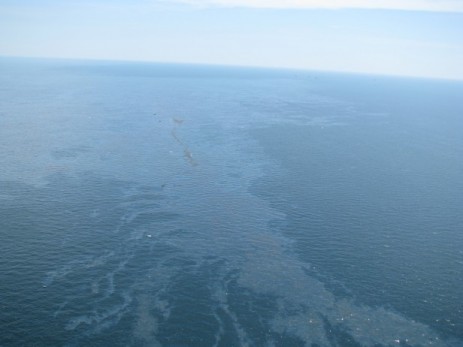 Photo: U.S. Coast Guard
Photo: U.S. Coast Guard
Cross-posted from Wonk Room.
The catastrophic gusher of oil unleashed by the explosion of BP’s Deepwater Horizon rig last week is on track to quickly exceed the 1989 Exxon Valdez spill, an independent expert warns. An explosive burst of oil destroyed the exploratory rig 41 miles off the Louisiana coast on the eve of Earth Day, killing 11 workers. After the shattered hulk of the rig sank to the ocean floor a mile down, the pipeline continues to spew oil that has now reached shore, with an end weeks or months away. John Amos, the president and founder of the nonprofit firm SkyTruth, “which specializes in gathering and analyzing satellite and aerial data to promote environmental conservation,” estimated from satellite photos that the calamity is increasing at a rate of 850,000 gallons (20,000 barrels) a day:
That’s right: more than 6 million gallons spilled into the Gulf of Mexico so far. This, and other radar images that SkyTruth is getting, confirm what we’ve seen on the NASA/MODIS images so far, and support our conservative calculations showing that in the first week of this spill at least 6 million gallons have entered the Gulf. That’s a spill rate of at least 850,000 gallons (20,000 barrels) per day, 20 times larger than the official Goast Guard estimate of 42,000 gallons per day.
By today, about 7 million gallons will have been spilled, taking the Deepwater Horizon disaster more than halfway to the 1989 wreck of the Exxon Valdez, which dumped 11 million gallons into Alaska’s Prince William Sound — one of the nation’s worst environmental disasters. This catastrophe — which occured as Halliburton was cementing the well — will exceed the scale of the Exxon Valdez within a week.
The sea of oil spewing from the mangled pipeline is already larger than 31 nations. After the Montara oil platform blew up in Australia’s Timor Sea last August, it took 10 weeks to stop the flow of oil. If recent history is any guide, it may be months before the sea of oil stops growing.
On April 22, the U.S. Coast Guard estimated the flow rate to be 336,000 gallons of crude a day, but BP officials claimed on Sunday that the rate was only 42,000 gallons a day. By Thursday, officials admitted that the disaster is increasing at least 210,000 gallons a day, much closer to the Coast Guard’s original estimate. Amos called that estimate a “bare-bones limit.”
No additional drilling has been authorized and none will until we find out what happened here and whether there was something unique and preventable here. No domestic drilling in new areas is going to go forward until there is a adequate review of what’s happened here and of what is being proposed elsewhere.


